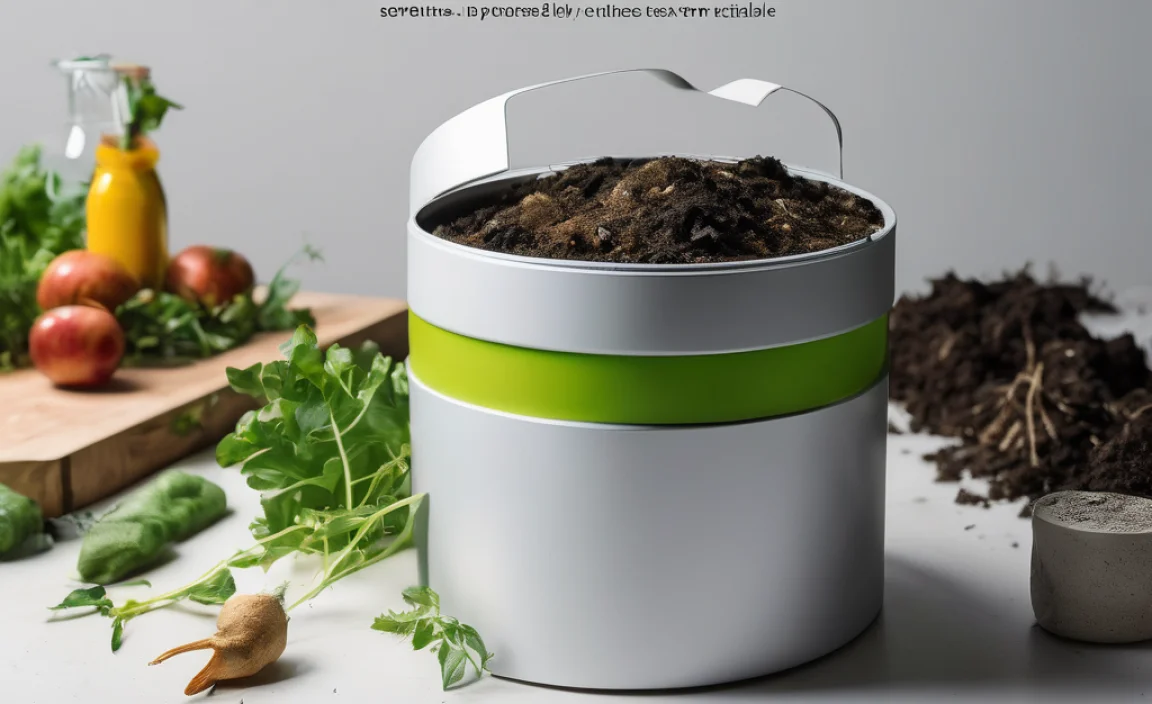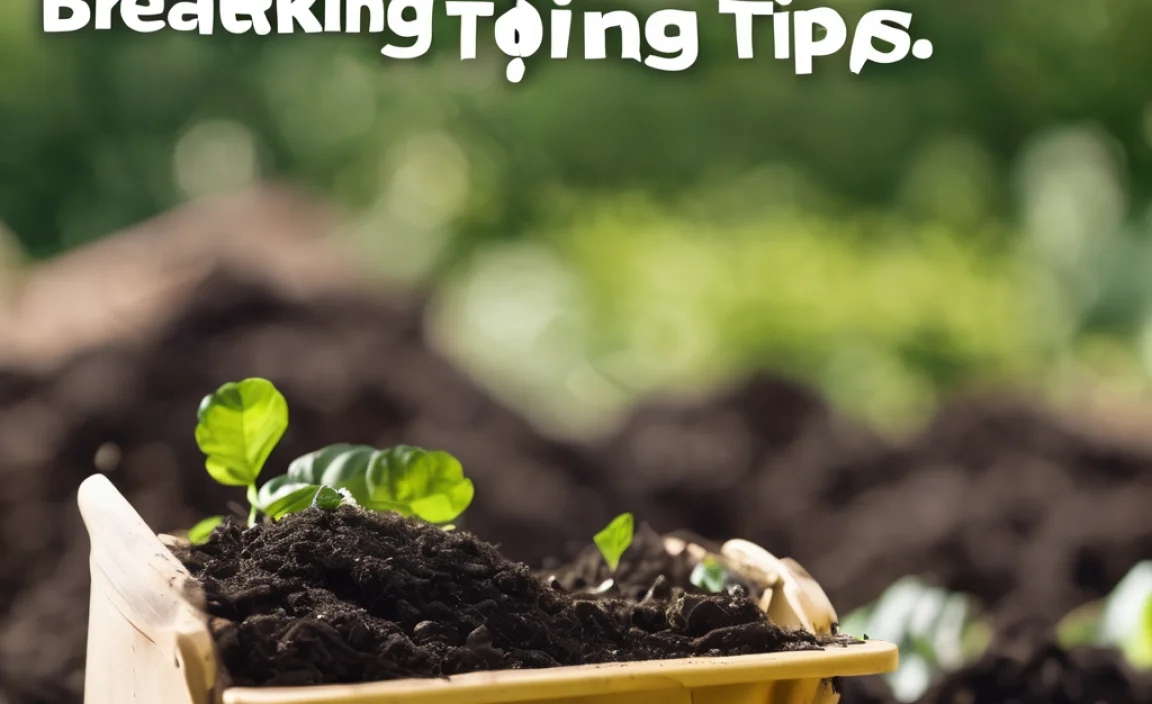So, you’ve started a compost pile, which is awesome! But maybe it’s not quite smelling like a forest floor and more like… well, something less pleasant. Don’t worry, we’ve all been there. Composting is a natural process, and sometimes nature needs a little friendly guidance. It’s easy to make a few small slips when you’re just getting started. This guide will walk you through common compost pile mistakes and, more importantly, how to easily fix them. Let’s turn those composting oopsies into triumphs!
Common Compost Pile Mistakes and How to Easily Fix Them
Starting a compost pile is a fantastic way to reduce kitchen scraps and yard waste while creating nutrient-rich “black gold” for your garden. But sometimes, things don’t go quite as planned. You might end up with a stinky mess, a pile that just won’t break down, or one that attracts unwanted guests. The good news is, most compost pile mistakes are super simple to fix. Let’s dive into the most common blunders and how to turn them around, so you can get back to making that amazing compost!
Mistake 1: The Smelly Pile – Too Much of a Bad Thing (or Not Enough Air!)
This is probably the most common and off-putting compost pile mistake. A stinky compost pile (think rotten eggs or ammonia) usually means one of two things: either you’ve packed it too tightly with too many “greens” (like food scraps and grass clippings) or it’s not getting enough air.
Why it Happens:
- Anaerobic Decomposition: When organic matter breaks down without enough oxygen, it enters what’s called anaerobic decomposition. This process produces stinky gases like hydrogen sulfide (rotten egg smell) and ammonia.
- Too Many “Greens”: “Greens” are nitrogen-rich materials (food scraps, grass clippings, coffee grounds). While essential for a healthy pile, too many without enough “browns” (carbon-rich materials) can create a dense, wet mat that suffocates the beneficial microbes.
How to Fix It:
Don’t panic! A smelly pile is usually salvageable.
- Aerate Your Pile: Grab a pitchfork or a compost aerator tool and turn the pile thoroughly. Aim to mix the outer layers into the center and vice versa. This introduces oxygen and helps dry things out a bit. You might need to do this every few days until the smell dissipates.
- Add “Browns”: If your pile looks or feels too wet and slimy, it’s time to add more carbon-rich “brown” materials. Think dry leaves, shredded cardboard (uncoated), straw, or sawdust. These materials don’t just balance the nitrogen from the greens; they also add air pockets, improving aeration. Aim for a ratio of roughly 2-3 parts browns to 1 part greens.
- Chop it Up: If you’ve been adding large items, they can mat together and reduce airflow. Breaking down your ingredients into smaller pieces speeds up decomposition and helps prevent these dense patches.
Mistake 2: The Slow-Moving Pile – Nothing’s Happening!
You’ve diligently added your kitchen scraps and yard waste, but weeks (or months!) later, your compost pile looks pretty much the same. Where’s the magic? This sluggishness often stems from an imbalance in the pile’s ingredients, lack of moisture, or insufficient aeration.
Why it Happens:
- Too Many “Browns”: While browns are essential, an excess of carbon-rich materials without enough nitrogen can slow down microbial activity. Think of it like throwing gas on a fire, but forgetting the igniter.
- Too Dry: Compost microbes need moisture to thrive. A dry pile is a dormant pile.
- Lack of “Activators”: Sometimes, a pile needs a little nudge to get going. These are nitrogen-rich materials that provide the fuel for decomposition.
- Large Material Size: Big chunks take a lot longer to break down than small ones.
How to Fix It:
Give your compost pile a boost!
- Add Nitrogen (“Greens”): If your pile is mostly dry leaves and twigs, it needs more “greens.” Toss in some fresh kitchen scraps (fruit and vegetable peels, coffee grounds, tea bags), fresh grass clippings, or even a bit of manure if you have access to it.
- Water It: The ideal moisture level for a compost pile is like a wrung-out sponge – damp but not dripping. If your pile feels dry, water it thoroughly while turning. Be careful not to overwater, as this can lead to Mistake 1!
- Turn It: Aerating your pile doesn’t just fix smells; it also redistributes moisture and activates dormant areas.
- Chop Materials: Before adding new items, or when turning, try to break down larger pieces into smaller ones. This dramatically increases the surface area for microbes to work on.
Mistake 3: The Uninvited Guests – Pests and Critters
A compost pile shouldn’t be an all-you-can-eat buffet for rodents, flies, or other unwanted visitors. If your pile is attracting more attention than you’d like, it’s likely due to what you’re putting in it or how you’re managing it.
Why it Happens:
- Meat, Dairy, and Oily Foods: These items are highly attractive to pests and can also lead to foul odors, creating a real draw for critters.
- Exposed Food Scraps: If fresh food scraps are left visible on the surface of the pile, they become an easy target for flies and other insects.
- Improper Bin Design: Open bins or piles without barriers can be easy access for larger animals.
How to Fix It:
Make your compost pile less appealing to pests.
- Avoid Pungent Items: Steer clear of meat, fish, bones, dairy products, and greases. Generally, compost is for plant-based materials. Check out resources from your local EPA for a comprehensive list of what to compost.
- Bury Food Scraps: Always cover fresh kitchen scraps with a layer of “browns” (leaves, shredded paper, sawdust). This hides the food and helps to absorb odors.
- Use a Contained System: Consider using a compost bin with a lid. Tumbler composters are also excellent for keeping pests out effectively.
- Maintain the Pile: Keep your pile moist (but not too wet) and turn it regularly. A well-managed, actively composting pile generates heat that can deter some pests. A quick tip: if you notice a lot of fruit flies, it’s often a sign the pile is too wet or has too many exposed greens.
Mistake 4: The Wet & Soggy Mess – Too Much Moisture
We touched on this with the smelly pile, but excess moisture deserves its own spotlight. A soggy compost pile is unpleasant to work with, can lead to anaerobic conditions (and those dreaded smells), and significantly slows down the decomposition process.
Why it Happens:
- Too Many “Greens”: High-nitrogen materials often contain a lot of water.
- Rain or Overwatering: Compost bins without adequate drainage or piles left uncovered during heavy rain can become waterlogged.
- Lack of “Browns”: The carbon-rich brown materials act like sponges, absorbing excess moisture and improving airflow.
How to Fix It:
Dry it out and balance it up!
- Add Dry “Browns”: This is your primary weapon against a soggy pile. Stir in generous amounts of dry leaves, straw, shredded cardboard, or sawdust. These materials will soak up excess water and add air pockets.
- Turn More Frequently: Aerating the pile helps trapped moisture to evaporate.
- Cover Your Pile: If you get a lot of rain, consider using a tarp or a compost bin with a lid to prevent it from becoming saturated. Ensure there’s still some airflow, though!
- Improve Drainage: If your bin sits directly on a solid surface, consider elevating it slightly or ensuring there are plenty of drainage holes at the bottom.
Mistake 5: The Dry & Dusty Pile – Not Enough Moisture
On the flip side, a compost pile that’s too dry simply won’t break down. The microorganisms responsible for composting need moisture to live and work. A dry pile might feel light and crumbly, with little signs of decomposition.
Why it Happens:
- Too Many “Browns”: A pile dominated by dry materials like leaves or shredded paper will lack moisture.
- Hot, Dry Weather: In arid climates or during heatwaves, piles can dry out quickly.
- Poor Location: A compost pile located in direct, scorching sun with no shade can lose moisture rapidly.
- Lack of Cover: Wind can also dry out the surface layers of a compost pile.
How to Fix It:
Hydrate and activate!
- Water Thoroughly: This is the most direct fix. Use a hose with a spray nozzle or a watering can to moisten the pile. Water it deeply as you turn it, aiming for that “wrung-out sponge” consistency throughout.
- Add “Greens”: Introduce more moisture-rich nitrogen materials. Food scraps, fresh grass clippings, or even a sprinkle of aged manure can help.
- Turn Regularly: Turning the pile helps distribute the moisture evenly.
- Consider Location: If possible, move your compost pile to a spot that gets some shade during the hottest part of the day.
- Cover Loosely: A loose cover or tarp can help retain moisture in very dry conditions, but make sure air can still circulate.
Mistake 6: The “What Can I Compost Anyway?” Confusion
Sometimes, the biggest mistake is simply not knowing what goes in the compost bin! Using the wrong materials can lead to smells, pests, or simply a pile that won’t break down effectively.
What to Compost (The “Greens” and “Browns”):
A healthy compost pile is a balanced mix of “greens” (nitrogen-rich) and “browns” (carbon-rich). Aim for a ratio of about 2-3 parts browns to 1 part greens by volume.
| Greens (Nitrogen-Rich – Moist) | Browns (Carbon-Rich – Dry) |
|---|---|
| Fruit and vegetable scraps | Dry leaves |
| Coffee grounds and filters | Shredded newspaper (non-glossy) |
| Tea bags | Shredded cardboard (uncoated) |
| Fresh grass clippings | Straw or hay |
| Plant trimmings (non-diseased) | Wood chips or sawdust (use sparingly) |
| Eggshells (crushed) | Paper towels (printed with soy-based ink) |
| Manure (from herbivores like chickens, cows, horses) | Dried pine needles (use sparingly, can be acidic) |
What to AVOID Composting:
- Meat, fish, bones, and dairy products (attract pests, cause odors)
- Oily or greasy foods (attract pests, cause odors)
- Diseased plants (can spread disease back to your garden)
- Weeds that have gone to seed (can spread weeds)
- Treated wood or sawdust (can contain harmful chemicals)
- Pet waste (from dogs and cats – can contain pathogens; herbivore manure like rabbit or chicken is fine)
- Coal ash or charcoal briquette ash (can contain harmful chemicals)
- Glossy or coated paper/cardboard (often contains plastics or chemicals)
- Synthetic materials (plastics, polyester, etc.)
Mistake 7: Not Turning Your Compost Pile Enough (or Too Much!)
The balance of turning your compost pile is key. Too little turning means poor air circulation and slow decomposition. Too much aggressive turning can sometimes dry out the pile too quickly or disturb the beneficial microbial communities.
Why it Happens:
- Forgetfulness or Laziness: Life gets busy! It’s easy to forget to turn the pile.
- Over-Enthusiasm: You might think more turning equals faster compost, but sometimes nature needs a little quiet time.
- Using the Wrong Tools: A heavy, packed pile can be intimidating to turn, leading to avoidance.
How to Fix It:
Find your rhythm!
- The Sweet Spot: A good rule of thumb for most backyard compost piles is to turn them every 2-4 weeks. If you’re aiming for faster compost (hot composting), you might turn more often, perhaps every 1-2 weeks, especially when the pile is actively heating up. For a more passive approach (cold composting), turning less frequently is fine, but decomposition will take longer.
- Observe Your Pile: The best indicator is your pile itself. If it’s smelling, it likely needs turning and aeration. If it’s not breaking down, turning can help introduce new materials and oxygen. If it’s dry, turn it while watering.
- Use the Right Tools: A sturdy garden fork or a dedicated compost aerator makes turning much easier. For smaller bins, even a garden trowel can work.
- Focus on Aeration: The primary goal of turning is to introduce oxygen. Imagine you’re fluffing a pillow; you want to break up compacted areas and mix the materials.
Mistake 8: The Immobile Pile – Not Building It Effectively
You might have a good pile of materials, but if they’re just sitting there without a proper structure or airflow, decomposition will be slow. Building your pile correctly from the start sets it up for success.
Why it Happens:
- Just Piling Materials: Simply dumping greens and browns on top of each other without mixing or layering.
- Lack of Base: Not starting with a good base of coarse browns for drainage and airflow.
- Materials Too Fine: Piling up only very fine materials can lead to compaction and poor airflow.
How to Fix It:
Layer and mix for better results!
- Start with a Base: Begin any new compost pile or bin with a layer of coarse “browns” (like small twigs, straw, or wood chips). This helps with drainage and air circulation from the bottom up.
- Layer Greens and Browns: When adding fresh materials, alternate layers of “greens” and “browns.” A common practice is to have a layer of browns, then greens, then browns, and so on. This ensures a good mix from the outset.
- Mix as You Go: Instead of just dumping, mix your new materials into the existing pile somewhat. This helps introduce new ingredients to the active composting core. For example, if you have a bin, try to push old material to the center and add new material around the edges, then mix it in on your next turn.
- Consider the Size: For efficient hot composting, a pile needs to be at least 3 feet by 3 feet by 3 feet (1 cubic yard). This size helps it retain heat. For smaller gardens or less active composting, smaller piles or bins work fine, they just might break down more slowly.
- Follow the “Lasagna” Method: This popular technique involves creating distinct layers, much like making lasagna, ensuring a good mix of greens and browns for consistent decomposition. For more on this, check out guides from horticultural societies or university extensions, such as those often found on Purdue University’s Extension.
Quick Summary: Common Compost Pile Fixes at a Glance
Here’s a handy table to quickly reference your compost troubleshooting needs:




